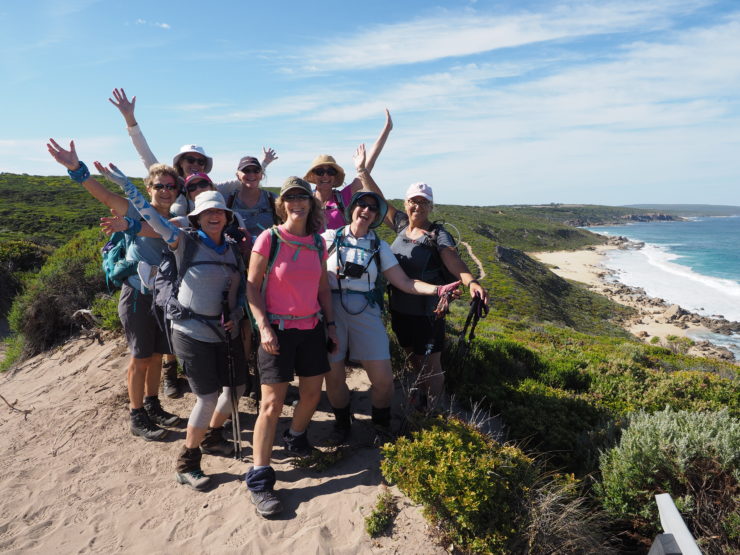How to train for a walking holiday

How to train for a walking holiday
Posted on
Any holiday you take will be better if you’re prepared. Sipping cocktails on the beach in Hawaii? You want to buy a good book, a new swimsuit and plenty of sunscreen. Staying in downtown Kathmandu? Invest in a guidebook, and learn a few key words (if in doubt, put your hands together and say “namaste”). And the best preparation for a walking holiday? Get walk-fit.
Getting walk-fit will increase your enjoyment when you’re on your holiday and help prevent injury. Plus, training for a walking holiday is an excellent way to improve your overall wellbeing and health. In fact, even if you’re not planning a walking holiday just yet, getting walk-fit is a worthy pursuit.
Follow our steps below to get walk-fit and ready for whatever life throws your way.
1 What’s the goal?
The first step is to find out what sort of walking you’ll be doing on your walking holiday. Walking holidays vary from carrying what feels like your every possession on your back and scaling mountains, to strolling the streets of Rome. So make sure you have an answer for these questions:
How many days will you walk? What distances will you cover? Are there rest days? How much will you carry? What’s the terrain like?
Once you know this, you can tailor your training to suit.
2 Where are you at?
Understanding where you’re at with your fitness right now is the best place to start any training program. It’ll help you map out a plan to get from where you are to where you’re going.
You’ll probably find yourself somewhere along the following scale:
1. I haven’t exercised regularly (other than incidental exercise) for a while
2. I do weight bearing exercises but little or no cardiovascular exercise
3. I walk (or run or ride or swim) frequently but don’t do any weight bearing exercise
4. I have a varied exercise regime including cardiovascular and weight bearing exercise
3 Getting the mix right – cardio vs strength training
The optimum training regime for a walking holiday will vary depending on what type of holiday you’re going on. If you have to carry a heavy backpack and climb a lot of hills you’ll want to add a bit more strength training into the mix.
For our style of walking holidays, where guests don’t carry anything heavier than their daypack, you’re going to want to do mostly cardiovascular exercise – that is, get you heart pumping and your lungs working. This will ensure you make it to the end of each day’s walk without too much huff and puff.
Good cardio fitness also means it’s easier to recover, so you’ll be able to appreciate the view at the top of a hill rather than appreciate your feet as you bend over them with your hands on your knees.
Strength training is important too. It’s your muscles that will get you up those hills so help them out and get them prepared. Don’t worry though – you don’t have to pump iron at the gym to strengthen your muscles.
4 The exercises that will give you results
The best cardio exercise to prepare for a walking holiday is walking, because it uses all the same movements and muscles that you’ll be using on your holiday. You’ll toughen your feet, lubricate your joints and strengthen all the right muscles!
Walk on varied terrains and surfaces that are similar to those that you will encounter on your holiday. If you’re doing a coastal walk you’re likely to come across some sandy sections, so take some long walks on the beach. Start near the waterline where it’s firm; and once you get fitter, seek out the soft stuff and challenge yourself. On any bushwalking holiday the terrain is likely to be uneven, so welcome opportunities to get off the pavement and onto the rough.
For your strength training you want to concentrate mainly on the legs. But don’t neglect your arms, shoulders and back, because even carrying a daypack can tire your muscles. And those walking poles won’t hold themselves up.
We recommend four key exercises to help you build strength in your legs.
1. Squats;
2. Lunges (forward and backward);
3. Bridging; and
4. Calf raises
For any strength training it’s really important to have correct technique. For example, with squats and lunges you always want to keep your knees in line with your hips and feet (no rolling them inward!) and never allow your knee to travel further forward than your toes.
If you’re unsure, the best way to learn good technique is to look up videos on YouTube (here’s one for bridging).
In the coming weeks we’ll show you how to do a number of strengthening exercises you can do, so make sure you come back and check out our videos.
5 How much you should do
This will depend on where you are at when you start your training and where you need to be for your holiday. For all levels of fitness, try to walk at least three times per week, building up the distance you walk each week.
Start out with a distance or time you’re comfortable with. This might range from 15 minutes for someone who hasn’t exercised for a while, to an hour or more for someone who walks regularly.
Next, record the distance that you cover in your initial walks. From there you can design a walking program where you increase your distance a bit each week to get to your goal distance in the weeks preceding your holiday.
If the distances you will be walking are long (say 17 to 25 km), aim to have a few similar length walks under your belt a couple of weeks prior to the holiday. Most of your walks aren’t going to be that long though. Aim for regular walks of about 5 to 10 km and throw in some long walks on consecutive days. Unless you live at Everest Base Camp, then 10kms should take you maximum 3 hours on uneven ground with undulating terrain.
And when you can’t walk longer, walk faster. It’ll elevate your heart rate more and get you fitter than if you stroll.
Two sessions a week of strength training is ideal when you’re preparing for your holiday. Space these out over the week to give you maximum chance to rest and build new muscles. If you’re starting from a low base, pick one exercise to start with and do ten repetitions. If you can’t make it to ten, take a short break and finish them off. Even if it takes the whole Four Corners episode, you will get there in the end!
Increase your strength training over time so that in each session you are doing 10 to 14 repetitions of each of the 4 different exercises above. Then go through the same circuit twice more.
The second to final step is stretching. Believe us – it’s worth doing.
The final step is to relax, perhaps with a nice glass of wine. Because you deserve it.
What are your favourite exercises for getting walk-fit? Let us know in the comments below.



